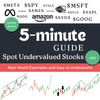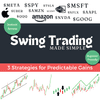
📊 Unlock Powerful Stock Charts!
Get real-time data, custom indicators, and in-depth stock analysis with TradingView.
Try TradingView FreeDon’t Buy Another Stock Until You Understand Debt/Equity Ratios
Wed, May 28, 2025
Table of Contents
Say your friend wants to open a cozy café. They’ve got $15k saved up but need a total of $45k to really get things going. So they borrow $30k from the bank.
Now the business is built on both what they own and what they owe. They put in $15k, borrowed $30k. That’s a debt/equity ratio of 2.0. Just means for every $1 of their own, they’re running on $2 of someone else’s.
Companies work the same way. This ratio just shows how much of a company’s operations are funded through debt vs what’s actually owned by shareholders.
How do you calculate it?
Pretty simple:
total debt ÷ shareholders’ equity
You’ll find both numbers on the company’s balance sheet. No advanced math needed. You can pull these from a site like TradingView or any other stock screener.
What’s a good debt/equity ratio?
Depends on the company. And the business they’re in.
If the ratio’s under 1, they’re mostly funding themselves. Stable, lower risk.
If it’s over 2, they’re borrowing more than they’re putting in. That can mean faster growth—or more pressure when things don’t go as planned.
The sweet spot kind of depends on how predictable the business is.
Does the industry make a difference?
Yeah totally. Different industries have different “normal.”
$XOM (ExxonMobil) runs heavy on debt because oil projects need a ton of upfront spending. 2.0+ is fine there.
$ASAN (Asana), a tech company that’s not profitable yet, having that same ratio? Might raise eyebrows.
Banks like $JPM (JPMorgan Chase) will have high ratios, but that’s how their balance sheets are structured. They borrow to lend.
Comparing across industries doesn’t always work. Better to compare within the same space. A stock screener can help line up industry peers quickly.
Is debt always a bad sign?
Not really. Debt can be useful. It helps companies grow faster or invest in big projects without waiting on cash reserves.
But it adds risk. Especially if sales slow down or interest rates go up. The issue isn’t debt itself—it’s whether the company can handle it.
Real company examples
$TSLA (Tesla) used to be more leveraged. Lately they’re around 0.45. Still using debt, but more controlled now.
$AAPL (Apple) sits closer to 1.5. They use debt mostly for buybacks and have enough cash to cover it.
$JPM (JPMorgan) is a bank—different rules. Their debt/equity ratio looks high, but you don’t use it the same way in finance.
What else should you look at?
The ratio’s helpful but kinda surface-level. If you really want to understand how safe or risky a company is, check a few other things:
- Interest coverage (can they pay what they owe each year?)
- Free cash flow (are they making enough actual money?)
- Debt maturity (when’s the debt due?)
- And whether the trend’s going up or down over time
Also doesn’t hurt to skim the company’s 10-K. See if leadership’s even talking about debt or just ignoring it.
You can track this stuff across your portfolio with a tool like Personal Capital, which pulls in balance sheet data and gives you a clearer view of your holdings.
When is the ratio actually useful?
If you're just looking at a company and wondering how it's built—this helps.
Some businesses are held up by strong revenue and equity. Others are more like borrowed scaffolding. This ratio shows you the difference.
It won’t tell you everything, but it gives you a sense of how stable or stretched they might be.
The quick takeaway
If a company’s borrowing, ask what they’re using it for.
If they’re not borrowing, ask if they’re missing growth opportunities.
If the number feels high, don’t panic—check if they can afford it.
Debt/equity isn’t a red flag. It’s just a flashlight. Use it to see what kind of ground a company’s standing on.
You can also keep an eye on your own investing mix with apps like M1 Finance or Robinhood, especially if you’re tracking companies with different capital structures.
Not financial advice, just sharing my thoughts!
Related Posts
Free Cash Flow - This One Number Reveals What a Company Really Makes
Fri, Jun 6, 2025
Learn what free cash flow really means, how to calculate it, and why it matters more than revenue in stock analysis.
Gross Margin - This One Metric Can Make or Break a Business — Here's Why
Thu, Jun 5, 2025
Learn how gross margin works, why it matters to investors, and what it reveals about a company’s pricing power and cost structure.
🌟 Buy Me Coffee
Love the market insights, stock analyses, and investing tips I share? Help me do more by buying me coffee. Your support funds deeper research, keeps content ad-free, and helps create more tools and resources for the community.


